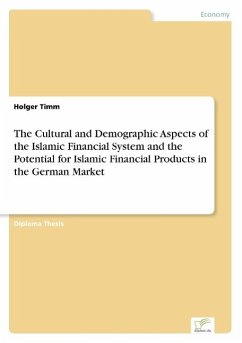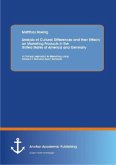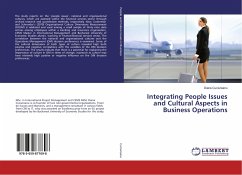Diploma Thesis from the year 2004 in the subject Business economics - Investment and Finance, grade: 1,4, Stralsund University of Applied Sciences (Wirtschaft), language: English, abstract: Inhaltsangabe:Abstract:
The aim of this thesis is to show the potential Muslims in Germany have concerning their number and financial power. As assumed, whilst developing the idea for this work, no financial institution is existent in Germany which offers banking services in compliance with Islamic law. Would it not make sense to introduce such instruments in a market which accommodates more than 3 million Muslims? Are the hurdles for introduction too high or is the financial potential of the Muslim population too low to care about such questions? They will be answered in this thesis.
To gather information necessary for writing this thesis, the author read various books about Islam, its roots, and its financial systems. The World Wide Web was a valuable source, especially publications of data by statistical offices, ministries, and institutions dealing with the topic. For certain parts specific data were not accessible to the author. For investigation purposes he wrote letters and mails to various institutions to find out that specific data were not available and certain statistical investigations were not undertaken. In that case approximations and extrapolations were used and marked as such.
The author has divided the thesis in four parts. The first chapter, Chapter A Islam History, Cultural Aspects, and Principles for the Financial System , introduces Islam, its roots and foundation about 1,400 years ago. In that chapter basic Islamic principles are explained and their relevance in all aspects of Muslim life is shown. With those principles underlying, a financial system developed which is different from the Western one. The development of the financial system is described as are various Islamic financial tools explained.
In Chapter B Muslims in Germany it is shown how the Muslim community in Germany developed. It is explained when processes of migration started and to what extent they developed. The cultural and educational Status Quo of the Muslim community is analysed, and it is looked at their stand concerning school, work, associations, etc. Thereby Islamically cultural distinctions are outlined and resulting obstacles for integration deduced. Following that, the financial Status Quo is looked at. Facts about Muslim savings are provided and examples of instruments available at the German market, which are in compliance with Islamic law, are described. Out of the outlined facts in the Status Quos a potential analyses is developed. Future scenarios about shifts in the population structure are calculated and thereby resulting changes at the labour market predicted. After combining the analyses it was assumed that changes in the population structure and at the labour market may result in changes in the income structure, which is looked at in the following.
After the Muslim community and its financial situation is analysed, Chapter C - Possibilities for Islamic Products in the German Market describes legal requirements set by German authorities as does it look at Islamic prescriptions for the running of a financial institution. Proposals are given how to harmonise differences to create possibilities for a financial system which encompasses both conventional and Islamic finance. Afterwards descriptions of product examples are provided which are in compliance with German law and with Islamic law. Finally a conventional equity financing model is analysed and ways of its transformation into an Islamically acceptable model are developed. It is calculated if such a model can be operated efficiently and profitably.
In Chapter D Conclusions Deduced from the Thesis final remarks are given concerning results achieved in the process of analysing the marke...
The aim of this thesis is to show the potential Muslims in Germany have concerning their number and financial power. As assumed, whilst developing the idea for this work, no financial institution is existent in Germany which offers banking services in compliance with Islamic law. Would it not make sense to introduce such instruments in a market which accommodates more than 3 million Muslims? Are the hurdles for introduction too high or is the financial potential of the Muslim population too low to care about such questions? They will be answered in this thesis.
To gather information necessary for writing this thesis, the author read various books about Islam, its roots, and its financial systems. The World Wide Web was a valuable source, especially publications of data by statistical offices, ministries, and institutions dealing with the topic. For certain parts specific data were not accessible to the author. For investigation purposes he wrote letters and mails to various institutions to find out that specific data were not available and certain statistical investigations were not undertaken. In that case approximations and extrapolations were used and marked as such.
The author has divided the thesis in four parts. The first chapter, Chapter A Islam History, Cultural Aspects, and Principles for the Financial System , introduces Islam, its roots and foundation about 1,400 years ago. In that chapter basic Islamic principles are explained and their relevance in all aspects of Muslim life is shown. With those principles underlying, a financial system developed which is different from the Western one. The development of the financial system is described as are various Islamic financial tools explained.
In Chapter B Muslims in Germany it is shown how the Muslim community in Germany developed. It is explained when processes of migration started and to what extent they developed. The cultural and educational Status Quo of the Muslim community is analysed, and it is looked at their stand concerning school, work, associations, etc. Thereby Islamically cultural distinctions are outlined and resulting obstacles for integration deduced. Following that, the financial Status Quo is looked at. Facts about Muslim savings are provided and examples of instruments available at the German market, which are in compliance with Islamic law, are described. Out of the outlined facts in the Status Quos a potential analyses is developed. Future scenarios about shifts in the population structure are calculated and thereby resulting changes at the labour market predicted. After combining the analyses it was assumed that changes in the population structure and at the labour market may result in changes in the income structure, which is looked at in the following.
After the Muslim community and its financial situation is analysed, Chapter C - Possibilities for Islamic Products in the German Market describes legal requirements set by German authorities as does it look at Islamic prescriptions for the running of a financial institution. Proposals are given how to harmonise differences to create possibilities for a financial system which encompasses both conventional and Islamic finance. Afterwards descriptions of product examples are provided which are in compliance with German law and with Islamic law. Finally a conventional equity financing model is analysed and ways of its transformation into an Islamically acceptable model are developed. It is calculated if such a model can be operated efficiently and profitably.
In Chapter D Conclusions Deduced from the Thesis final remarks are given concerning results achieved in the process of analysing the marke...








